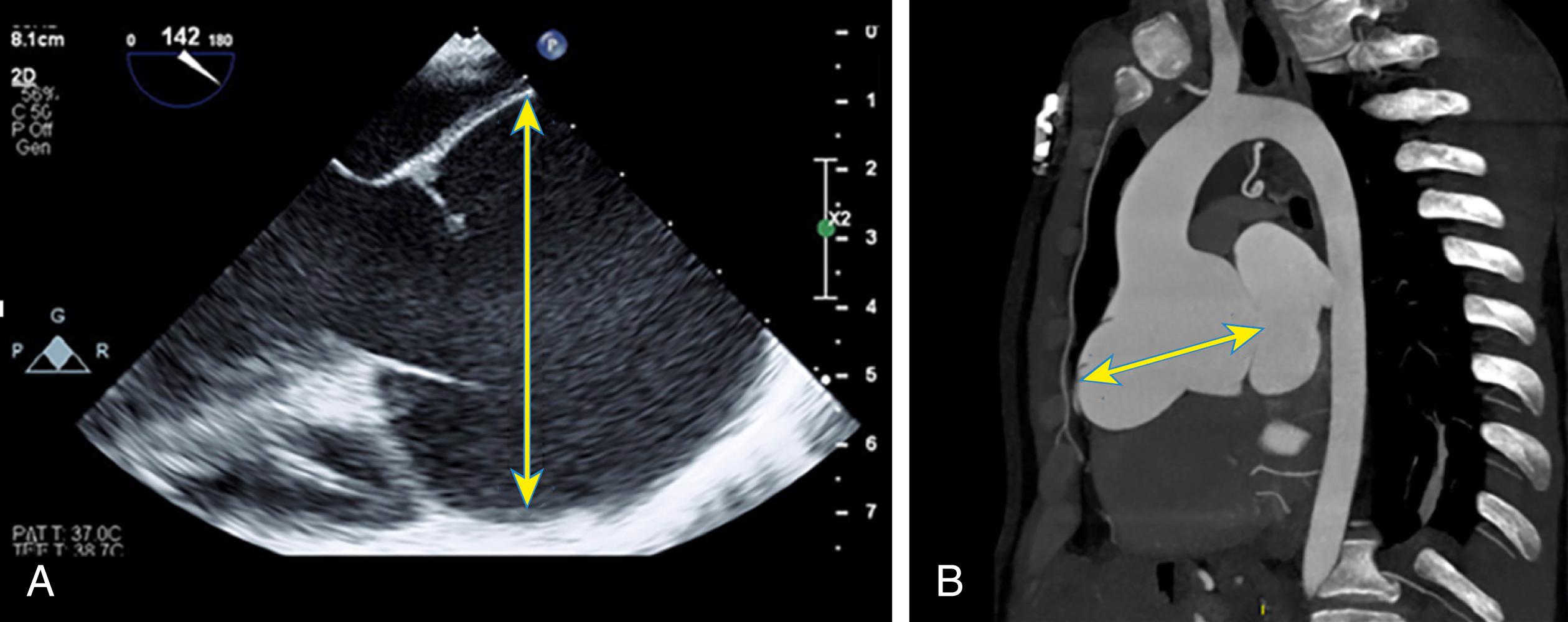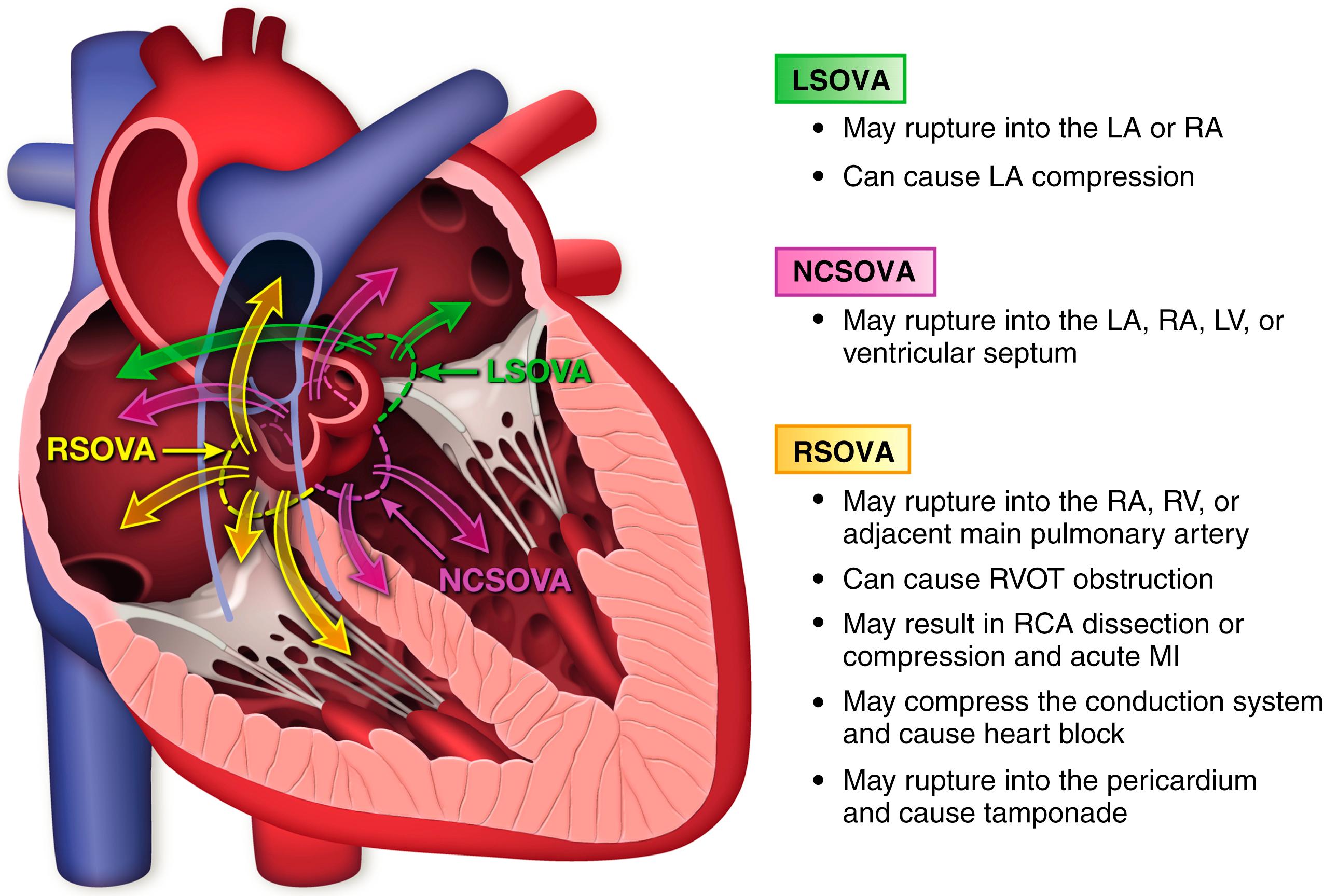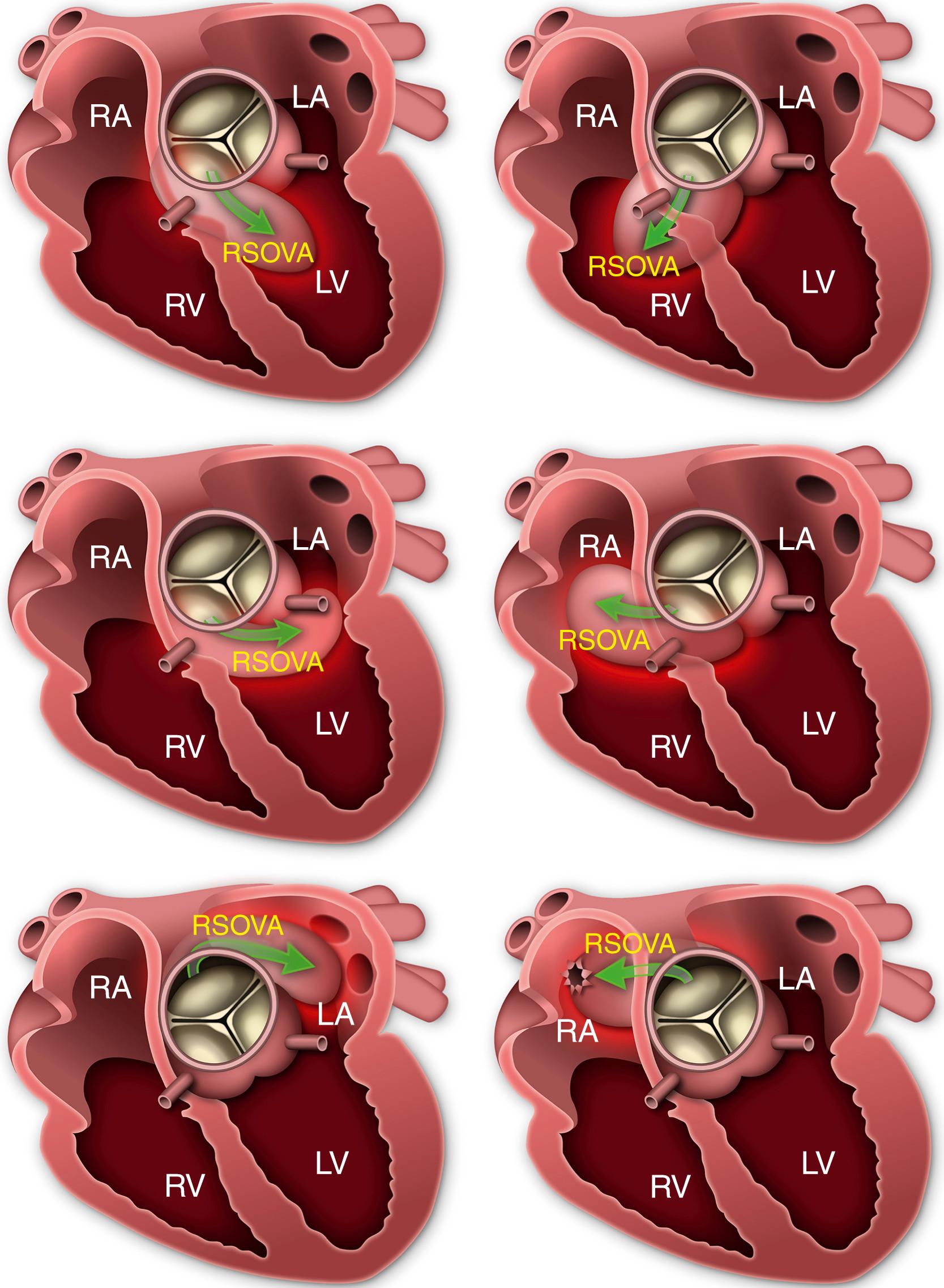Physical Address
304 North Cardinal St.
Dorchester Center, MA 02124
The sinuses of Valsalva are cuplike dilatations in the aortic wall just above the three cusps of the aortic valve (AV). These sinuses function in part to suspend the AV between the valve annulus and the sinotubular ridge. In addition, the left and right sinuses house the ostia of the left and right coronary arteries ( Fig. 132.1 ). Aneurysm of the sinus of Valsalva was first described by Hope in 1839. In 1840, the first six cases were described by Thurnam , with a description that aneurysms of the sinuses of Valsalva usually protrude into one of the cardiac chambers. Subsequently, Smith and coworkers described sinus of Valsalva aneurysms (SOVAs) found during postmortem examination. Aneurysms of the sinus of Valsalva are thought to result from incomplete fusion of the medial layer of the aorta with the annulus fibrosis of the AV. The medial layer lacks an elastic lamellae, which creates a weakness in the aortic wall, making it susceptible to dilatation and aneurysm formation, especially in the presence of hypertension.
In general, sinuses of Valsalva aneurysms are rare, and they may be caused by acquired conditions or congenital conditions ( Table 132.1 ). SOVAs are frequently associated with other cardiac congenital abnormalities such as ventricular septal defect (VSD), anomalous coronary arteries, or abnormal AV cusps (bicuspid and quadricuspid). In instances of bicuspid AV, not only does the congenitally abnormal valve result in complications, such as regurgitation or stenosis, but a concomitant aortopathy may coexist. The aortopathy most commonly affects the ascending aorta; however, SOVA may also be an accompaniment of bicuspid or quadricuspid AV ( Fig. 132.2 ).
| Congenital | Acquired |
|---|---|
| Bicuspid aortic valve | Endocarditis |
Connective tissue disease
|
Iatrogenic postaortic valve surgery or cardiac catheterization |
| Atherosclerotic degeneration |

The clinical presentation varies depending on the site and size and whether compressive symptoms or rupture into a cardiac chamber or extracardiac site occurs. Hence, with sinus of Valsalva causing right ventricular inflow or outflow tract obstruction, right-sided heart failure symptoms will predominate. A fistula into the right atrium (RA) or right ventricle (RV) will present the same, but fistula into the left atrium may present with predominantly left-sided heart failure ( Fig. 132.3 ).

The sinuses of Valsalva characteristically rupture into an adjacent chamber ( Table 132.2 and Fig. 132.3 ). The cause is generally thought to be congenital because of abnormal ultrastructural changes in the medial layer (cystic medial necrosis) of the sinus wall. This may be congenital or acquired as in endocarditis or rarely may be iatrogenic after coronary angiography or after AV surgery. In known connective tissue disease abnormalities (Marfan, Treacher-Collins, or Ehlers-Danlos syndromes) or in patients with a unicuspid, bicuspid, or quadricuspid AV or coarctation of the aorta, abnormal elastic tissue may be seen.
| Ruptured Sinuses | Unruptured Sinuses |
|---|---|
| RSOVA may rupture into RA, RV, or adjacent main pulmonary artery | RSOVA can cause RVOT obstruction |
| LSOVA will rupture into the LA or RA | LSOVA can cause LA compression |
| RSOFA may result in right coronary artery dissection or compression and acute MI | RSOVA may compress the conduction system and cause heart block |
| RSOVA may rupture into the pericardium with tamponade |
In the presence of a membranous VSD, prolapse of the noncoronary cusp or the right coronary cusp into the VSD by a windsock mechanism may occur. In one large study of SOVAs spanning almost half a century, 63% of participants were male; asymptomatic incidental murmur was noted in 20%; fatigue was noted in 45%; and dyspnea and chest pain were noted in 36% and 19%, respectively; and palpitations were noted in 5%. Symptoms in SOVA are largely dependent on which sinus dilates and the size and the relationship with adjacent structures. Symptoms may be caused by compressive aneurysms on the coronary arteries or obstructive to right ventricular inflow or right ventricular outflow tract (RVOT) outflow or left-to-right or left-to-left shunting or less commonly may cause conduction system abnormalities by impinging on conduction fibers in the interventricular septum or atrial ventricular node. Extracardiac rupture within the pericardium or mediastinum is extremely uncommon. Aneurysms arose from the right coronary sinus in 70%, the noncoronary sinus in 25%, and the left coronary sinus in 5% of patients. The aneurysms had ruptured in 29 of the patients (34%). Twenty percent ruptured into the RV and 13% into the RA. All the ruptured aneurysms arose from the right coronary sinus (76%) or the noncoronary sinus (24%). Aneurysms originating in the noncoronary sinus tended to rupture into the RA (86%), and those originating in the right coronary sinus tended to rupture into the RV (73%). Most right coronary sinus aneurysms rupture into the RV, either into the body or into the outflow tract. In the Mayo series, 20% of all SOVAs opened into the RV and 13% into the RA. Of the right coronary sinus aneurysms, most (73%) opened into the RV. Aneurysms of the noncoronary sinus ruptured into the RA in 86% of patients. Rarely, rupture may occur into the left ventricle, left atrium, pulmonary artery, pericardium, interventricular septum, or superior vena cava. It is safe to say that approximately two-thirds of SOVAs arise from the right sinus of Valsalva; two-thirds will rupture into the RV, two-thirds are male, one-third arise from the noncoronary sinus of Valsalva, one-third rupture into the RA, one-third present with rupture, and 20% to 25% are asymptomatic and discovered incidentally. Approximately 6% have endocarditis. Frequently, the presentation may be insidious with gradual symptom presentation over several years. It may be discovered incidentally on imaging or clinically through a continuous murmur. The subacute or insidious presentation is that of congestive heart failure from volume overload or RVOT obstruction.
With regard to clinical presentation, it generally may be acute with chest pain or more commonly with heart failure. Symptoms of acute or subacute dyspnea on exertion or right-sided heart failure symptoms if the aneurysm results in right-sided volume overload by rupture into the RA or RV or if RVOT obstruction or tricuspid valve inflow obstruction occurs. Fig. 132.4 outlines examples of a right and noncoronary SOVA and putative chamber into which it may enlarge. These account for greater than 90% of all SOVAs. Of note, the relationship of the SOVA and coronary arteries reflects the mechanism for coronary artery compression and angina type pain or acute coronary syndrome that may result.

Become a Clinical Tree membership for Full access and enjoy Unlimited articles
If you are a member. Log in here